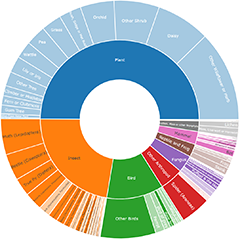Announcements
24 Sep 2025
Hi NatureMapr Data Collector app users,If you experience the following error when attempting to upload sightings from the NatureMapr Data Collector mobile app, please note the following known issue an...
Continue reading
NatureMapr moves to simpler, flatter national structure
Mobile App update and known issues
Discussion
Tapirlord
wrote:
16 Sep 2025
Hi libbygleeson, thanks for your sighting. It looks like the location information you provided is incorrect. This can occur if the GPS sensor in your device was having a bad day. Please review and update the location of this record when you get a chance.
Unverified Other Shrub
RogerF
wrote:
1 Sep 2025
Can we have a pictures of a living specimen dorsal and side view if possible
Perelytrana sp. (genus)
RogerF
wrote:
19 Aug 2025
Not Perelytrana as outside range.
P. rana black soil SW plains NSW -see 468603
P. sp #1. black soil plains NW NSW (not far west) - no records on CNM although very common.
P. rana black soil SW plains NSW -see 468603
P. sp #1. black soil plains NW NSW (not far west) - no records on CNM although very common.
Lagoonia sp.
Significant sightings
- Phaps histrionica at Tibooburra, NSW
- Choerocoris variegatus at Euabalong, NSW
- Monistria discrepans at Cobar, NSW
- Monistria pustulifera at Tibooburra, NSW
- Pterostylis cobarensis at Mutawintji, NSW
- Drosera finlaysoniana at Mutawintji, NSW
- Philotheca linearis at Mutawintji, NSW
- Philotheca linearis at Gunderbooka, NSW
- Acanthiza robustirostris at Gunderbooka, NSW
- Polyzosteria mitchelli at Mount Hope, NSW
Top contributors
- MB 694
- Tapirlord 399
- Darcy 320
- Liam.m 110
- NedJohnston 91
- SimoneC 81
- AaronClausen 63
- Petesteamer 58
- JimL 55
- Christine 55
Top moderators
- Liam.m 512
- Tapirlord 459
- Darcy 443
- MatthewFrawley 124
- MichaelBedingfield 117
- MichaelMulvaney 26
- PatrickCampbell2 21
- MartinPredavec 20
- RogerF 18
- BrianLR 11














